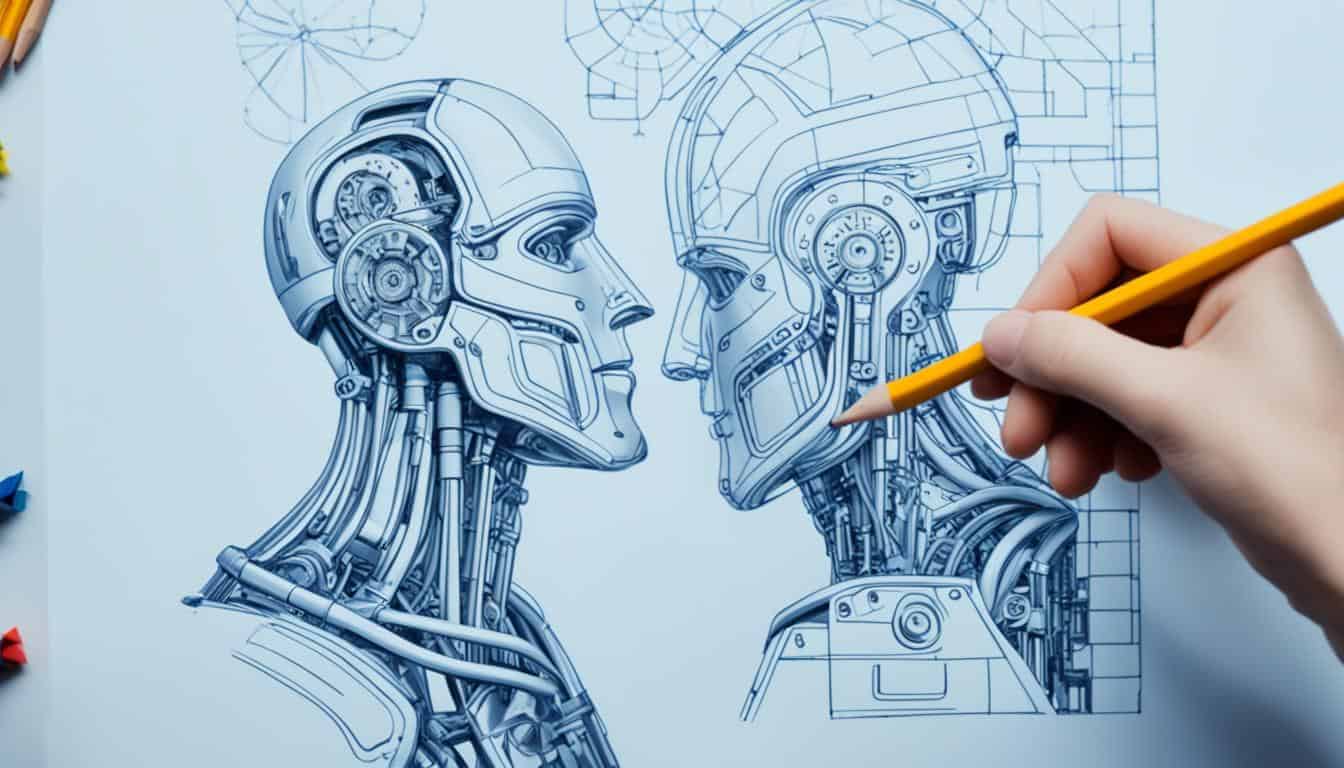
Did you know that businesses using artificial intelligence for writing save about 30% of the time it takes to make a blog post? As a writer, I’ve seen how AI tools are changing our work, making us think about the good and bad of this change.
The debate between AI and human writing is getting more intense. AI is great at being fast and efficient. On the other hand, human writers add creativity and emotional depth. This article will look at the pros and cons of both sides.
We’ll dive into how AI is changing content creation and why human content is still very valuable. We’ll also see how to mix the best of both worlds for top-notch, engaging content.
Key Takeaways
AI writing tools can reduce content production time by 30%
Human writers excel in creativity, storytelling, and emotional connection
AI lacks originality and depth compared to human-written content
Combining AI and human skills can optimize content creation strategies
The future of writing likely involves collaboration between AI and humans
AI in Content Creation
AI is changing the way we create content. As a writer I’ve seen how AI tools are making a big difference. These tools use machine learning and natural language processing to create text that’s almost like human language.
What is AI and how does it work?
AI writing tools are computer programs that create content. They look at lots of data to learn about language and writing styles. For example GPT-3 by OpenAI can write about many topics with just a little input. This is behind many of the writing helpers you see, which mimics human writing.
AI in content creation
AI is changing the way we create content in many areas. The Washington Post uses Heliograf an ai tool to write articles like sports updates and election results. The New Yorker uses Botnik for funny content. As a content creator I find ai tools great for idea generation, first drafts and SEO optimisation.
While AI is fast and consistent, human writers bring creativity and emotional depth that machines can’t match. The future of content creation will be a mix of humans and AI. Together they can create high quality content at scale, leveraging the strengths of both AI and the human writer.
Benefits and Drawbacks of AI-Generated Content
AI writing tools have changed how we create content, bringing both good and bad sides, including the ability to mimic human writing. Let’s look at the ups and downs of using AI for making content.
Advantages of AI Writing Tools
AI content generation has many benefits. These tools work non-stop, creating content all day, every day. This means more work gets done faster, making them great for busy schedules.
AI can make lots of content quickly, perfect for keeping things up to date. It’s also great for making summaries fast.
Cost-effective: AI tools often cost less than hiring professional writers
Scalable: Can produce large amounts of content efficiently
Consistent: Maintains a uniform tone and style across various pieces
Disadvantages of AI Writing Tools
AI tools have their downsides too. They can’t match the creativity and emotional connection of human communication. The content they produce sounds too generic and impossible to relate to.
Quality issues: May produce shallow and unoriginal content
Plagiarism: Risk of copying existing content
Lack of ideas: Struggle to come up with new ideas
Bias: Can perpetuate biases in the training data
| Aspect | Human Writers | AI Writing Tools |
|---|---|---|
| Creativity | High | Limited |
| Speed | Slower | Faster |
| Cost | Higher | Lower |
| Emotional Depth | Rich | Limited |
The Value of Human-Generated Content
Human content has a special sauce that AI can’t replicate because human writers possess unique creativity and emotional intelligence. As a writer I’ve seen how human creativity and emotional intelligence makes stories work. Let’s look at the strengths and limitations of human content.
The Human Touch in Writing
Human writers bring stories to life, touch readers. We get the nuance, pick up on the subtleties and add our own personality. That’s why our content resonates and engages more than AI.

56% of participants preferred AI-generated content when unaware of its source
52% of consumers disengage when they suspect content is AI-generated
25% feel brands are impersonal when using AI for social media copy
Limitations of Human Writers
Human creativity has its own hurdles. Creating content takes us about 69 minutes, while AI does it in 16 minutes. This time gap can slow us down. Keeping up with lots of content is hard for humans too. Yet, the value of human-created content is clear in making real, engaging stories that reach readers.
Finding the Right Balance: Human-AI Collaboration
Human-ai collaboration has changed how we make content. By mixing AI and human creativity, we open up new ways to write. The goal is to balance AI’s speed with human insight.
Blending AI and Human Creativity
AI writing tools have grown a lot, making writing faster and better. They do the easy tasks like grammar checks, so writers can focus on the hard stuff. This mix of ai and human creativity makes work more consistent and better.

AI can look at lots of data to find patterns we can’t see. This helps with creative ideas. It can learn about language differences and use that in writing. This makes making content on a big scale possible.
Case Studies of Successful Integration
Here are examples of how AI and human skills work well together:
The Associated Press uses AI for basic reports, and humans add headlines and make it better.
Grammarly uses AI for grammar checks and humans for quality writing.
| Aspect | AI Contribution | Human Contribution |
|---|---|---|
| Speed | Fast text generation | Refined editing and context |
| Creativity | Pattern recognition | Original ideas and emotion |
| Accuracy | Data processing | Fact-checking and nuance |
Using AI and human creativity together lets us make content that grabs readers. It also keeps making content efficient.
Guidelines for Integrating AI into Content Creation
AI content tools are changing the game for writers and marketers. Know when to use AI and when to use human writers. Let’s get into it.
When to Use AI-Generated Content
AI writing tools are good for certain tasks. They’re great for things that need speed and can handle lots of data. Here’s when I recommend using AI:
First drafts
Product descriptions for e-commerce
Data-heavy reports
Social media posts at scale
Personalized email campaigns
AI has made 68% of businesses more productive in content. But AI content lacks facts.
When to Use Human-Generated Content
Human writers are unmatched in areas where AI can’t keep up. I’ve seen that humans are best at:
Crafting emotionally resonant stories
Developing unique brand voices
Creating in-depth, original analysis
Writing persuasive sales copy
Producing thought leadership content
Studies show that human writers beat AI in making content that connects with people. They’re great at using audience insights and brand preferences.

| Criteria | AI Content Tools | Human Content Writers |
|---|---|---|
| Speed | Fast | Moderate |
| Originality | Limited | High |
| Emotional Appeal | Low | High |
| Data Processing | Excellent | Good |
| Brand Voice Consistency | Inconsistent | Consistent |
The key is finding a balance. By using both AI and human skills, we can make content that’s efficient and engaging. Remember, AI tools should help, not replace, human creativity in making content.
Comparative Analysis: AI vs. Human Content
In the world of content creation, the debate between AI and human content is big. I looked into the main differences between AI and human-made content. I focused on how fast and how good they are.
Content Creation Speed
AI writing tools have changed how we make content. There are now 24 AI tools for writing content fast. They work non-stop, meeting deadlines easily. On the other hand, humans take longer but add depth and new ideas to their work.

SEO and Fact-Checking
AI is great at handling lots of data for SEO. It quickly adds keywords and makes content better structured. But, humans create content that connects with readers on a deeper level.
Checking facts is key for good content. AI can check info fast but might give wrong facts or old data. Humans are better at analyzing and explaining complex ideas simply. This mix of AI and human work is important, as Google says it helps content show up better in searches.
| Aspect | AI Content | Human Content |
|---|---|---|
| Speed | Fast, 24/7 availability | Slower, limited by human factors |
| SEO Optimization | Efficient keyword integration | Nuanced, context-aware optimization |
| Fact-Checking | Quick processing, potential errors | Critical analysis, reliable accuracy |
Ethical Considerations and Challenges
Addressing concerns about job displacement, content quality, and transparency
The integration of AI in writing raises important ethical considerations and challenges. One of the primary concerns is job displacement, as AI writing tools may potentially replace human writers in certain industries. However, it’s essential to note that AI is not intended to replace human writers but rather to augment their capabilities and enhance their productivity.
Another concern is content quality, as AI-generated content may lack the nuance and emotional depth that human writers bring to their work. To address this, it’s crucial to ensure that AI writing tools are trained on high-quality data and that human writers are involved in the editing and refinement process to guarantee the content meets the desired standards.
Transparency is also a vital aspect of AI-generated content. It’s essential to disclose when content is generated by AI and to provide clear guidelines on the role of AI in the content creation process. This transparency will help build trust with readers and maintain the integrity of the content.
Moreover, there are concerns about bias and fairness in AI-generated content. AI models can perpetuate existing biases if they are trained on biased data, which can lead to unfair or discriminatory content. To mitigate this, it’s crucial to ensure that AI models are trained on diverse and representative data sets and that human writers are involved in the content creation process to detect and address any potential biases.
Finally, there are concerns about authorship and ownership of AI-generated content. As AI writing tools become more prevalent, it’s essential to establish clear guidelines on authorship and ownership to ensure that creators are fairly credited and compensated for their work.
The Future of Writing: A Hybrid Approach
Combining the strengths of AI and human writing
The future of writing is likely to be characterized by a hybrid approach that combines the strengths of AI and human writing. AI writing tools will continue to improve, enabling them to generate high-quality content quickly and efficiently. However, human writers will still be essential for adding creativity, emotional depth, and contextual understanding to the content.
In this hybrid approach, AI writing tools will be used to generate initial drafts, perform research, and analyze data. Human writers will then review, edit, and refine the content to ensure it meets the desired standards. This collaboration will enable writers to focus on high-level creative work, such as developing ideas, crafting compelling narratives, and adding emotional resonance to the content.
Moreover, AI writing tools will be used to assist human writers in various aspects of the writing process, such as suggesting alternative phrases, providing grammar and spell checks, and offering insights on content optimization. This will enable human writers to work more efficiently and effectively, freeing them up to focus on the creative aspects of writing.
The hybrid approach will also enable writers to produce content that is more personalized, engaging, and relevant to their audience. By combining the strengths of AI and human writing, writers will be able to create content that resonates with readers on a deeper level, builds trust, and drives engagement.
Ultimately, the future of writing will be characterized by a symbiotic relationship between AI and human writers. AI will augment human capabilities, enabling writers to produce high-quality content more efficiently and effectively. Human writers will bring creativity, emotional depth, and contextual understanding to the content, ensuring that it resonates with readers and achieves its intended purpose.
Best Practices for Human-AI Collaboration
The secret to a great partnership between AI and humans is using their strengths together. By combining the best of AI and human skills, we can make our work much stronger.
Tips for Successful Collaboration
Here are some tips for making human-AI teams work well:
Use AI for first drafts and data checks, so writers can focus on creativity and feeling
Have an editorial team check AI content to make sure it fits your brand
Give feedback to AI tools to help them get better over time
Check your content making process often to find the best mix of AI and human skills
From what I’ve seen, the human touch is still key. AI is great at handling data and coming up with ideas, but humans add depth, empathy, and smart thinking. Together, we can make content that’s both efficient and touches people’s hearts.
The aim isn’t to replace human writers. It’s to help them do their jobs better. By using AI as a tool, we can make things run smoother. This lets writers spend more time on creative and strategic tasks. This way, we get better results and happier content creators.
Summary
I love the future of writing where AI and human brains combine. Content creation is changing fast. Finding the right balance of AI’s speed and human creativity is key to success.
AI tools like ChatGPT can write essays quickly and well, sometimes even better than humans in some areas. That’s what AI can do for us.
AI makes content creation fast and cheap. It can produce lots of content quickly and make it SEO friendly. But human writers add something special. Our creativity, emotional intelligence and ability to grasp subtleties make our content connect with people deep.
Writing is about working with AI and humans. Using AI for data and efficiency and keeping human creativity and feel we can create content that works and is engaging. As we move forward the balance will be key. It will help us develop content strategies that meet what readers want and what business needs.
